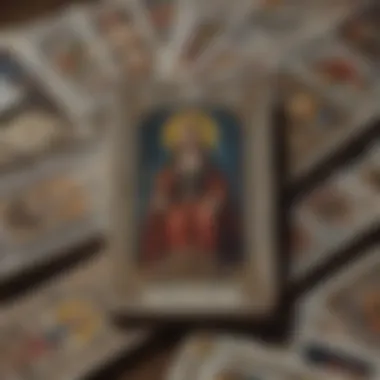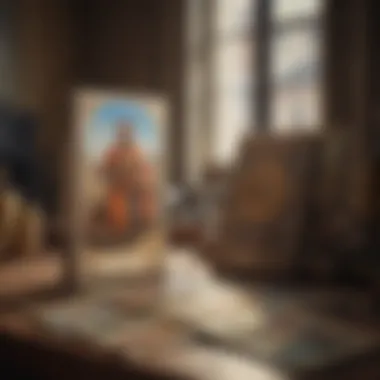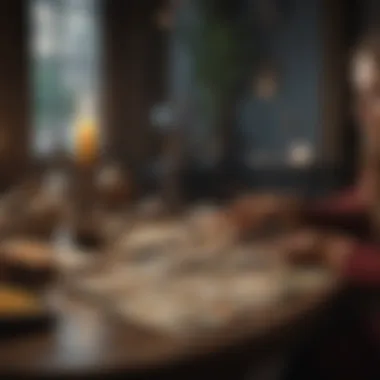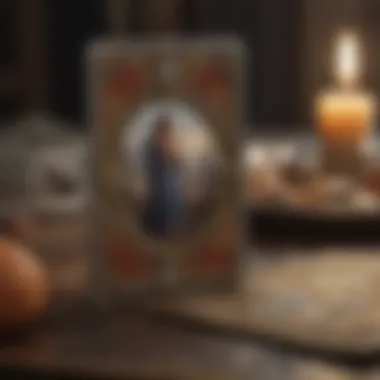The Marseille Deck: Unveiling Its Mystical Legacy


Intro
The Marseille Deck holds a prominent place in the world of tarot, recognized for its rich history and unique imagery. This exploration of the Marseille Deck seeks to illuminate its origins, characteristics, and practical application in spiritual practices today. Through understanding the nuances of these cards, both newcomers and experienced practitioners can enhance their readings and personal growth.
Zodiac Sign Overview
General Traits and Characteristics
Understanding the Marseille Deck goes beyond just the cards themselves. Each card carries symbolic resonance that reflects various human experiences and traits. For instance, the Fool card, with its imagery of a carefree traveler, symbolizes new beginnings and the spirit of adventure. Other cards like the Tower express change, shock, and transformation, while the Sun embodies optimism and clarity.
Elemental Associations
The imagery in the Marseille Deck is also interconnected with elemental associations—Earth, Air, Fire, and Water. Each element symbolizes various aspects of life and spiritual practice. Earth relates to material aspects and stability, while Air is tied to thoughts and intellect. Fire represents passion and creativity, and Water connects with emotions and intuition. These elements provide a deeper layer of interpretation to each card drawn during a reading.
Ruling Planets
Like astrology, tarot's relationship with planetary influences can deepen one’s understanding of card meanings. Each card in the Marseille Deck can also be associated with ruling planets. For instance, The Empress card can connect to Venus, signifying love and beauty, while the Emperor may relate to Mars, indicating strength and authority. Recognizing these associations can enrich the interpretive process during readings.
Compatibility Analysis
Relationship Dynamics with Other Zodiac Signs
The influence of the Marseille Deck can extend into understanding interpersonal connections. The cards can reflect relationship dynamics between different signs in astrology. For example, a reading might indicate challenges when air signs interact with earth signs due to differing communication styles and values.
Friendship Compatibility
Friendships can also benefit from exploring the insights of the Marseille Deck. For instance, a balance of elemental energies can support harmony among friends. A tarot reading might highlight the strengths and weaknesses within a friendship, guiding individuals toward better understanding and resolution.
Family and Workplace Relationships
Exploring familial and work relationships through the lens of tarot can offer profound insights. The Marseille Deck can reveal underlying tensions or shared strengths within families. In a workplace dynamic, the cards may suggest the need for adaptation or clearer communication among team members.
Astrological Influences
How Current Celestial Events Affect Each Sign
Celestial events shape the tarot experience in a powerful way. During a full moon, for example, drawing cards may emphasize completion and release. The Marseille Deck can serve as a guide to understanding how these cosmic occurrences influence personal and collective energies.
Monthly and Weekly Influences
Astrologically, specific tarot cards may take on heightened meanings during different times of the month or week. Advising individuals on how to use these influences is key, particularly when planning tarot sessions or personal reflections. Designating specific cards to align with particular times can enhance the reading's relevancy.
Personal Growth Opportunities Through Astrology
Finally, the intersection of tarot and astrology opens pathways to personal growth. The Marseille Deck encourages practitioners to reflect on their own patterns and behaviors. Understanding these can lead to a more profound self-discovery process, providing valuable lessons that contribute to the journey of life.
The Marseille Deck is not only a tool for divination but also a means to connect deeply with oneself and one's surroundings.
Through this exploration of the Marseille Deck, the reader can begin to appreciate the layers of meaning and connection it holds, both historically and in practice today.
Prelude to the Marseille Deck
The Marseille Deck holds a significant place in the history of tarot. Understanding its core elements enhances one's grasp of tarot not just as a divination tool but also as a profound cultural artifact. This section discusses the necessity of comprehending the Marseille Deck and sheds light on its practical implications.
First and foremost, the Marseille Deck distinguishes itself with its unique artistic style. Unlike many modern tarot decks, which often focus on intricate imagery and symbolism, the Marseille Deck aligns more with simplicity and directness in its representation. This stark imagery makes it a valuable tool for both newcomers and experienced practitioners, enriching their reading process.
Moreover, exploring the Marseille Deck can deepen one’s knowledge of tarot history and evolution. It serves as a bridge between historical practices and modern interpretations. Familiarizing oneself with the Marseille Deck allows astrologers, tarologists, and esoteric practitioners to gain insights into the shifts in tarot usage over time. The structural layout is also paramount; understanding the division between Major and Minor Arcana in the Marseille system is crucial for an accurate reading.
"The Marseille Deck is not merely a set of cards; it is a gateway to understanding the evolution of human thought and spirituality."
Another important aspect is how the Marseille Deck influences interpretation. As it possesses a straightforward approach, it encourages a more intuitive reading style. Readers often find that engaging with the Marseille Deck helps in developing personal interpretations that may differ from standard meanings often associated with more illustrative decks.
Historical Background


Understanding the historical background of the Marseille Deck is fundamental to appreciating its depth and significance. This section provides context on how the Marseille Tarot emerged, evolved, and influenced tarot practices. Knowing its origins and transformations helps practitioners connect with the deck on a deeper level. It also reveals how cultural, social, and artistic shifts shaped its symbolism and structure.
Origins of the Marseille Tarot
The Marseille Tarot's roots trace back to 16th century France, a period marked by a burgeoning interest in mysticism and the esoteric. The Marseille Deck, as we recognize it today, was not just a product of its time. It emerged from earlier tarot designs, which combined various traditions, including medieval Italian playing cards and allegorical illustrations.
Early decks were not standardized, leading to diverse interpretations and artistic expressions. The Marseille Tarot represents a pivotal moment in the codification of tarot symbolism. Key elements of the deck, such as the Major and Minor Arcana, began to take shape, providing a foundation for future tarot artists and readers. The prints from Marseille artisans, like Nicolas Conver, played a vital role in popularizing this style, making it accessible to a broader audience.
Evolution Through the Ages
As centuries progressed, the Marseille Tarot underwent several transformations, adapting to social changes and the evolving understanding of tarot. In the 18th century, the deck gained recognition with the rise of occultism in Europe, sparking public interest in tarot as a tool for divination and self-reflection. The illustrations became more stylized, and certain archetypes and symbols solidified, shaping the narrative within the cards.
The 19th and 20th centuries saw a resurgence of interest in the Marseille Tarot. Influencers like Papus and Aleister Crowley highlighted its significance alongside other tarot traditions, leading to a revival of the original aesthetics and meanings. Today, the Marseille Deck is appreciated not just for its historical value but also for its raw symbolic language that resonates with many tarot practitioners.
As we explore the Marseille Tarot further, its historical evolution shines light on its resilience and relevance in modern tarot practices, echoing the complexities of human experience across time.
Understanding the Structure
Understanding the structure of the Marseille Deck is vital in comprehending its interpretative depth and practical usage. The structure defines how cards are organized and how they relate to each other in readings. This knowledge can enhance one’s ability to read and interpret the cards effectively. It brings clarity and precision to the practitioner’s approach, allowing for more meaningful insights.
The Marseille Deck consists of two primary components: the Major Arcana and the Minor Arcana. Each component encompasses different aspects of life and experiences, making their understanding crucial for accurate readings. This section aims to unravel the features of the Major and Minor Arcana, helping readers appreciate the richness of the Marseille Tarot’s structure.
Major Arcana in the Marseille Deck
The Major Arcana is the heart of the Marseille Deck. It comprises 22 cards, each representing significant life themes and spiritual lessons. These cards are numbered from 0 to 21, beginning with The Fool and concluding with The World.
The importance of the Major Arcana lies in its focus on major life events and universal archetypes. For instance, The Fool symbolizes new beginnings and innocence, while The Tower represents sudden change and upheaval. Each card is packed with symbolism and imagery that invites reflection and insight.
Here are some key characteristics of the Major Arcana:
- Universal Themes: Each card reflects a theme that resonates across cultures and experiences.
- Spiritual Lessons: These cards guide practitioners in personal growth and self-discovery.
- Psychological Insights: The cards can unveil subconscious influences, providing depth in readings.
In readings, the Major Arcana can offer profound insights into situations, guiding individuals toward a deeper understanding of choices and their consequences.
Minor Arcana Explained
The Minor Arcana complements the Major Arcana by focusing on everyday events and challenges. It consists of 56 cards divided into four suits: Cups, Pentacles, Swords, and Wands. Each suit embodies different areas of life, such as emotions, material matters, intellect, and creativity.
Grasping the Minor Arcana is essential for a comprehensive tarot reading. Unlike the Major Arcana, which deals with broader themes, the Minor Arcana reflects the mundane aspects of life. This can include relationships, work, and daily decisions.
Key aspects of the Minor Arcana include:
- Four Suits: Each suit has 14 cards, including numbered cards (1-10) and four court cards.
- Specificity: The Minor Arcana provides specific insights into daily situations, making readings more relatable and actionable.
- Interplay with Major Arcana: The Minor Arcana often interacts with Major Arcana cards, revealing how everyday life is influenced by broader spiritual themes.
By mastering the Minor Arcana, practitioners can gain a nuanced understanding of the complexities in readings, allowing for more tailored advice derived from the cards.
Symbolism and Imagery
Symbolism and imagery are vital components of the Marseille Deck, playing a central role in its interpretation and understanding. Each card is imbued with deep meaning, reflecting cultural, historical, and psychological facets that resonate with both practitioners and seekers. The unique imagery found in this deck serves as a prism through which one can explore complex human emotions, experiences, and universal themes. By examining symbols, one unveils hidden truths that may lead to personal insights and broader awareness.
Iconography in the Marseille Deck
The iconography of the Marseille Deck embodies a rich tapestry of symbols that have evolved over centuries. Each card's illustrations are not mere decorations but are crucial to understanding its essence. For instance, the Fool is depicted in a manner that invites interpretation of spontaneity and new beginnings, while the High Priestess often signifies intuition and hidden knowledge.
Understanding these symbols allows a reader to access the deeper aspects of the tarot. They communicate messages that go beyond the surface, tapping into collective unconscious themes. Practitioners must consider these symbols carefully during readings to provide accurate insights to themselves or their clients.
- Key Symbols:
- The Fool: Represents beginnings and opportunities.
- The Tower: Symbolizes upheaval and sudden change.
- The Lovers: Reflects choices, relationships, and duality.
The impact of iconography is not solely on the individual cards but also on the relationships between them. When placed in certain spreads, their meanings can shift, offering new layers of interpretation. It is essential to recognize that these images have cycles of meaning, influenced by the context in which they appear.
Color and Its Meaning
Color profoundly influences the interpretation of the Marseille Deck. Each hue can carry its own emotional weight and energy. Understanding color theory in the context of tarot enhances one's ability to draw meaning from the cards.


- Red: Often associated with passion, action, and strength.
- Blue: Represents calmness, intuition, and reflection.
- Yellow: Signifies clarity, inspiration, and intellect.
- Green: Relates to growth, balance, and healing.
Colors engage the intuitive faculties of the reader. For example, a predominance of blue might suggest a need for reflective thought in a reading. Thus, recognizing the interplay of colors within the cards is a powerful tool for enhancing one's interpretive skills.
The relationship between symbolism and imagery is intricate. Each has the power to reveal multi-layered meanings, guiding practitioners in their readings and personal explorations.
Reading the Marseille Tarot
Reading the Marseille Tarot requires familiarity with its unique structure and imagery. This tarot system, distinct from others, offers a rich interpretive depth that can significantly enhance both personal readings and client consultations. Understanding how to navigate its nuances is crucial for any practitioner. Many enjoy the challenge presented by the Marseille Deck because it encourages an intuitive approach, allowing readers to explore deeper meanings in a less constrained framework.
Choosing the Right Spread
Selecting a spread is a vital step in the process of reading the Marseille Tarot. Different spreads serve various purposes; some are better for introspection, while others aid in decision-making. Common spreads include the three-card spread, which provides insight into past, present, and future, or the Celtic Cross, which explores a comprehensive view of a situation. When choosing a spread, consider the question at hand and the context of the reading.
Here are some considerations for ideal readings:
- Align with Purpose: Ensure the spread aligns closely with the purpose of the reading.
- Simplicity: Start with simpler spreads if you are new to the Marseille Deck.
- Flexibility: Adjust spreads if necessary, making them your own to better resonate with your style.
Interpretative Techniques
Approaching interpretation in the Marseille Tarot involves a blend of knowledge and intuition. Familiarity with the imagery is essential, as the symbolism in the Marseille Deck carries profound meanings. Here are some interpretative techniques to consider:
- Symbol Analysis: Delve into symbols presented in the cards, as they often convey specific messages or themes.
- Numerological Insights: Pay attention to the numbers on the cards. Each number can offer unique insights; for instance, the number 3 might reflect growth and creativity.
- Intuitive Connection: Trust your gut feelings about the situation or question posed. Personal interpretations can add depth.
- Contextual Relevance: Always regard the context in which the cards are drawn. Surrounding cards can influence meaning.
Common Mistakes to Avoid
Mistakes can hinder the reading process. Being aware of these can improve overall effectiveness:
- Rigid Interpretations: Avoid adhering strictly to traditional meanings. Flexibility in interpretation can lead to deeper insights.
- Overlooking Reversals: Some readers ignore reversed cards, but they can provide critical information about the dynamics at play.
- Neglecting Personal Intuition: Relying solely on guidebooks can limit your interpretations. Trust your instincts to create a personal reading style.
- Ignoring the Querent’s Input: Engage with the querent. Their input can guide your interpretations and make the reading more meaningful.
To conclude, mastering the art of reading the Marseille Tarot involves a blend of knowledge, intuition, and practice. By understanding the right spreads, honing interpretative techniques, and avoiding common pitfalls, practitioners can unlock the profound insights that this unique tarot system offers.
Practical Applications
The practical applications of the Marseille Deck are of utmost importance to both novice and experienced practitioners. Understanding how to utilize this tarot system in various contexts can dramatically enhance the reading experience. Not only does it provide insights into one's personal journey, but it also serves as a valuable tool for self-discovery and growth.
By examining two key areas—self-reflection and personal development—the profound benefits of the Marseille Deck become clear. Each aspect offers a unique lens through which practitioners can interpret their experiences and interactions with the world.
Using the Marseille Deck for Self-Reflection
Self-reflection is a vital part of personal growth. The Marseille Deck facilitates this process by providing imagery and symbolism that resonate with the user’s current life situations. When an individual lays out cards, they are prompted to contemplate their circumstances in a structured manner.
- Identifying Patterns: Patterns often reveal themselves through card placement and associations, helping individuals recognize recurring themes in their lives.
- Emotional Insights: The symbolism within the cards can evoke strong feelings, prompting the user to analyze their emotions and responses.
- Decision-Making: Cards can serve as guides in decision-making. When faced with a choice, a reading may reveal hidden aspects to consider.
Tuning into the energy of each card during a reading encourages deeper introspection. This dynamic interaction can significantly enhance one's understanding of personal motivations, desires, and fears.
Marseille Tarot in Personal Development
Incorporating the Marseille Tarot into personal development strategies can yield transformative outcomes. It offers a framework for setting intentions and achieving goals through its structured approach.
- Goal Setting: Cards can help clarify goals. By selecting cards that resonate with desired outcomes, individuals gain focus and direction.
- Strengthening Intuition: Regular readings cultivate intuitive abilities. Practitioners learn to trust their instincts, which can lead to more confident decision-making.
- Manifestation: Using the cards as a means to visualize goals can enhance manifestation efforts. The imagery serves as a reminder of aspirations.
Perhaps the most significant impact of the Marseille Deck in personal development lies in the empowerment it provides. Users learn to navigate life’s complexities with greater awareness and strategic thinking. Each card reading transforms into an opportunity for learning and adaptation.
Comparative Analysis
The comparative analysis of tarot decks serves as a vital section in this exploration of the Marseille Deck. Understanding the contrasts and similarities between different tarot systems enhances the comprehension of each deck’s unique characteristics. It allows practitioners to appreciate the historical context and cultural significance that inform their use. Moreover, comparative analysis offers insights that can improve one’s interpretive skills, guiding users in choosing the right deck for their needs.
Marseille Deck vs.
Rider-Waite Deck
The Marseille Deck and the Rider-Waite Deck stand as two of the most influential representations of tarot cards. Each evokes distinct methodologies and philosophies within tarot practice.


- Artwork and Symbolism: The Marseille Deck is renowned for its straightforward imagery and minimalist approach. It sticks to traditional symbols, encouraging intuitive interpretations. In contrast, the Rider-Waite Deck incorporates elaborate illustrations that depict scenes, enhancing narrative-based readings.
- Use in Readings: Readers using the Marseille Deck often rely on instinct and personal intuition. The symbolism can be abstract, requiring a deeper internal understanding. Alternatively, the Rider-Waite Deck provides visual narratives that may lead to more immediate interpretations for some users.
- Cultural Impact: The Rider-Waite Deck, developed in the early 20th century, significantly influenced how modern tarot is perceived. Its widespread availability and promotion have catapulted it into mainstream culture. The Marseille Deck, however, carries the weight of centuries of history, intertwining with European occult practices that date back to the 17th century.
Ultimately, choice between these decks depends on the reader's preference between tradition and modernity, intuition and illustrative guidance.
Cultural Influences on Tarot Design
The design of tarot decks is deeply intertwined with the cultural contexts from which they emerge. The Marseille Deck, with its roots in French culture, reflects societal beliefs and artistic trends of its time. It shows how art served both spiritual and practical needs in the community.
Conversely, the Rider-Waite Deck reveals influence from early 20th-century English society, notably the rise of spiritualism and the quest for psychological understanding. Such cultural elements shaped the imagery, themes, and interpretations of tarot cards, showcasing varying approaches to divination.
Some key factors to consider include:
- Historical Context: Each deck offers a window into the thoughts, ideas, and practices of its time.
- Artistic Trends: The styles of art prevalent during a deck's creation impact its visual messaging.
- Spiritual Influences: Local beliefs and practices inform the symbols attached to cards.
Understanding these cultural nuances allows practitioners to gain a richer insight into tarot readings, facilitating more profound connections with their decks.
Marseille Deck in Modern Context
The Marseille Deck holds a significant position in the realm of tarot, bridging the historical interpretations of the cards with contemporary usage. Its distinct visuals and rich symbolism prove to be not just remnants of the past, but also vessels of meaning that resonate within today's spiritual practices. For both astrologers and esotericists, understanding the relevance of the Marseille Deck now is essential for enhancing reading techniques and personal growth.
Influence on Contemporary Tarot Practices
In recent years, the Marseille Deck has re-emerged as a favored choice among modern tarot practitioners. This resurgence stems from several factors. First, there is a growing appreciation for traditional systems over newer models. The Marseille Deck, with its time-honored imagery and interpretative depth, provides a profound foundation to explore spirituality and self-awareness. Practitioners often find that its simplicity yields clarity in readings, allowing users to focus more on intuition rather than becoming overwhelmed by embellished imagery.
It is also noteworthy that many contemporary tarot decks draw inspiration from the Marseille Deck. Influenced artists incorporate its motifs into their creations, fostering a blend of old and new. The result is a diverse landscape of tarot options that still resonate with the core principles of traditional decks. This interplay elevates the Marseille Deck as a crucial tool for both learning and enhancing one’s practice. Moreover, the techniques of reading used by modern practitioners often return to basics, underscoring the enduring relevance of the symbolism inherent in the Marseille cards.
Revival of Interest in Traditional Decks
The revival of interest in traditional tarot decks, specifically the Marseille Deck, reflects a shift in seekers' attitudes toward spirituality. Today's practitioners are increasingly inclined to return to the roots of tarot, seeking authenticity in their practices. The Marseille Deck, with its rich history and straightforward representation, serves as a gateway to understanding the deeper meanings behind the cards.
This desire for authenticity often translates into community discussions, workshops, and online forums where users share insights and techniques related to the Marseille Deck. On platforms like Reddit and Facebook, groups are forming with the explicit purpose of encouraging these discussions.
"The Marseille Tarot is not just for fortune-telling; it is a powerful tool for introspection and growth."
Resources for Further Exploration
Resources for further exploration are crucial when delving into the depths of the Marseille Deck. Understanding tarot is not just about reading the cards; it's about immersing oneself in a rich tapestry of history, symbolism, and various interpretative techniques. By utilizing specific resources, practitioners can enhance their skills, refine their approaches to readings, and gain a more rounded appreciation of the Marseille tradition.
Finding the right materials helps to bridge gaps in knowledge. Books on the Marseille Deck provide historical context and detailed analysis of the imagery and symbolism inherent in the cards. Online communities and forums offer platforms for discussion and exchange. They create spaces for both novices and experienced tarologists to share insights, experiences, and interpretations. This communal aspect fosters learning, which is essential for personal growth and gains in spiritual practices.
An understanding of how to navigate and leverage these resources can transform one’s approach to readings and life experiences. With the diverse landscape of books and online discussions, each resource can contribute to a practitioner’s journey. This exploration leads to a more confident and nuanced use of the Marseille Deck.
Books on the Marseille Deck
Books focusing on the Marseille Deck range from historical overviews to practical guides on how to read the cards. They help educators, enthusiasts, and anyone interested in understanding the Marseille Deck better. A few key titles include:
- "The Tarot of Marseilles" by Paul Huson: This book blends history with practical insights, guiding readers through the meanings of each card and how to read them effectively.
- "Marseille Tarot: The Power of the Cards" by Erik C. Dunne: It explores the symbolic meaning behind the imagery, aiming to enhance interpretative skills.
- "The Marseille Tarot: A History" by Michael Dummett: A comprehensive historical account that places the Marseille Deck within the broader context of tarot's evolution.
These sources are valuable for their deep dives into materials relevant to the Marseille Deck. They can assist readers in grasping the nuances required for readings, enriching both skill sets and understanding of the broader spiritual significance.
Online Communities and Forums
Engaging with online communities is another critical resource. Platforms such as Reddit and Facebook host numerous groups dedicated to tarot discussions. These communities foster an inclusive environment for sharing knowledge and experiences. They are instrumental in:
- Discussion: Members can present questions and receive insights based on collective experiences.
- Resource Sharing: Users often post links to relevant articles, videos, and workshops that can aid in understanding the Marseille Deck.
- Peer Support: In these forums, both beginners and seasoned practitioners find encouragement, helping each to navigate their tarot journeys more easily.
Overall, harnessing the power of these online platforms provides practitioners with diverse perspectives and experiences, enhancing their engagement with the Marseille Deck. This exchange of ideas can lead to greater clarity and insight, propelling individuals further along their paths of spiritual discovery.
"Engaging with books and online communities enhances one’s understanding of tarot beyond basic readings."
The End
In this article, we have explored the Marseille Deck, a tarot system laden with history and symbolism. Understanding its significance offers various benefits to practitioners, both novice and experienced. The Marseille Deck is not merely a set of cards; it is a conduit for deeper introspection and spiritual growth.
The relevance of the Marseille Deck cannot be overstated. It challenges readers to confront their subconscious and engage with their innermost thoughts. Each card presents an opportunity for insight, making every reading a unique experience. As readers familiarize themselves with the unique imagery and historical context, they can unlock layers of meaning that enhance their interpretive skills.
When engaging with the Marseille Deck, several considerations arise. Practitioners should respect its traditional roots while recognizing its adaptability to modern contexts. The integration of this deck within personal practices not only deepens one's understanding of tarot but also facilitates personal development.
The Marseille Tarot is a timeless resource. Its ancient wisdom continues to resonate in today's spiritual landscape.
In sum, the learnings presented in this exploration highlight the Marseille Deck as a valued asset in tarot practice. It invites individuals to embark on a journey of self-discovery, urging them to explore not just the cards but also their inner selves.



